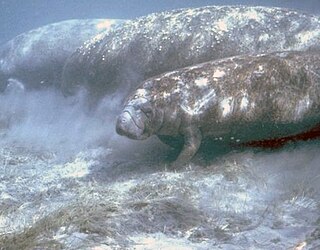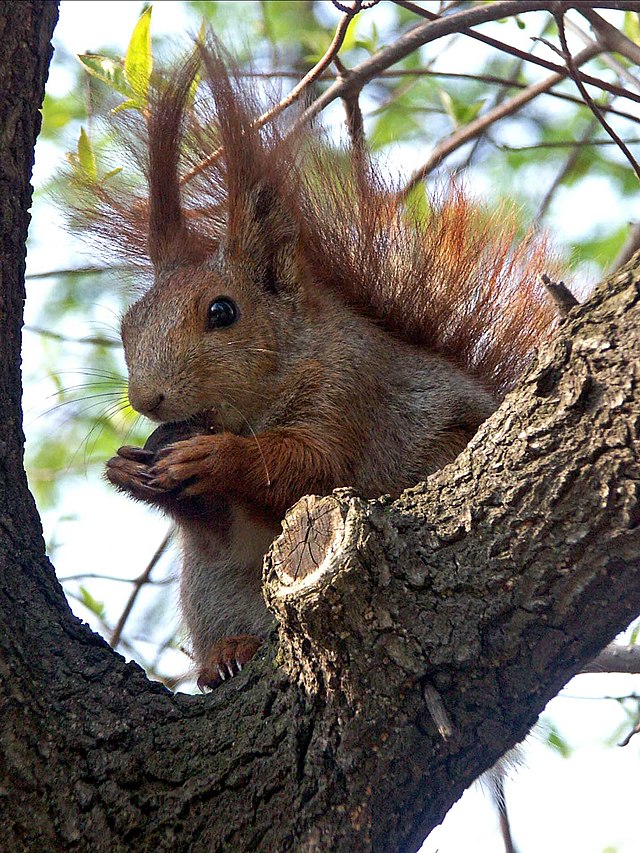Loading AI tools
This is a list of the mammal species recorded in Saint Kitts and Nevis. Of the mammal species in Saint Kitts and Nevis, one is vulnerable, one is near threatened, and one is classified as extinct.[1]
The following tags are used to highlight each species' conservation status as assessed by the International Union for Conservation of Nature:
| EX | Extinct | No reasonable doubt that the last individual has died. |
| EW | Extinct in the wild | Known only to survive in captivity or as a naturalized populations well outside its previous range. |
| CR | Critically endangered | The species is in imminent risk of extinction in the wild. |
| EN | Endangered | The species is facing an extremely high risk of extinction in the wild. |
| VU | Vulnerable | The species is facing a high risk of extinction in the wild. |
| NT | Near threatened | The species does not meet any of the criteria that would categorise it as risking extinction but it is likely to do so in the future. |
| LC | Least concern | There are no current identifiable risks to the species. |
| DD | Data deficient | There is inadequate information to make an assessment of the risks to this species. |
Some species were assessed using an earlier set of criteria. Species assessed using this system have the following instead of near threatened and least concern categories:
| LR/cd | Lower risk/conservation dependent | Species which were the focus of conservation programmes and may have moved into a higher risk category if that programme was discontinued. |
| LR/nt | Lower risk/near threatened | Species which are close to being classified as vulnerable but are not the subject of conservation programmes. |
| LR/lc | Lower risk/least concern | Species for which there are no identifiable risks. |
Infraclass: Eutheria
Order: Sirenia (manatees and dugongs)

Sirenia is an order of fully aquatic, herbivorous mammals that inhabit rivers, estuaries, coastal marine waters, swamps, and marine wetlands. All four species are endangered.
- Family: Trichechidae
- Genus: Trichechus
- West Indian manatee, T. manatus VU extirpated
- Genus: Trichechus
Order: Rodentia (rodents)

Rodents make up the largest order of mammals, with over 40% of mammalian species. They have two incisors in the upper and lower jaw which grow continually and must be kept short by gnawing. Most rodents are small though the capybara can weigh up to 45 kg (99 lb).
- Family: Cricetidae
- Subfamily: Sigmodontinae
- Genus: Pennatomys
- Nevis rice rat, P. nivalis EX
- Genus: Pennatomys
- Subfamily: Sigmodontinae
- Suborder: Sciuromorpha
- Family: Sciuridae (squirrels)
- Subfamily: Sciurinae
- Tribe: Sciurini
- Genus: Sciurus
- Red squirrel, S. vulgaris LC introduced
- Genus: Sciurus
- Tribe: Sciurini
- Subfamily: Sciurinae
- Family: Sciuridae (squirrels)
Order: Primates
The order Primates includes the lemurs, monkeys, and apes, with the latter category including humans.
- Family: Cercopithecidae
- Genus: Chlorocebus
- Green monkey, C. sabaeus LC introduced[2]
- Genus: Chlorocebus
Order: Chiroptera (bats)

The bats' most distinguishing feature is that their forelimbs are developed as wings, making them the only mammals capable of flight. Bat species account for about 20% of all mammals.
- Family: Noctilionidae
- Genus: Noctilio
- Greater bulldog bat, N. leporinus LC
- Genus: Noctilio
- Family: Molossidae
- Genus: Tadarida
- Mexican free-tailed bat, Tadarida brasiliensis LR/nt
- Genus: Tadarida
- Family: Phyllostomidae
- Subfamily: Brachyphyllinae
- Genus: Brachyphylla
- Antillean fruit-eating bat, Brachyphylla cavernarum LR/lc
- Genus: Brachyphylla
- Subfamily: Carolliinae
- Genus: Carollia
- Seba's short-tailed bat, Carollia perspicillata LR/lc
- Genus: Carollia
- Subfamily: Stenodermatinae
- Genus: Artibeus
- Jamaican fruit bat, Artibeus jamaicensis LR/lc
- Genus: Artibeus
- Subfamily: Brachyphyllinae
Order: Cetacea (whales)
The order Cetacea includes whales, dolphins and porpoises. They are the mammals most fully adapted to aquatic life with a spindle-shaped nearly hairless body, protected by a thick layer of blubber, and forelimbs and tail modified to provide propulsion underwater.
- Suborder: Mysticeti
- Family: Balaenopteridae (baleen whales)
- Genus: Balaenoptera
- Common minke whale, Balaenoptera acutorostrata
- Sei whale, Balaenoptera borealis
- Bryde's whale, Balaenoptera brydei
- Blue whale, Balaenoptera musculus
- Genus: Megaptera
- Humpback whale, Megaptera novaeangliae
- Genus: Balaenoptera
- Family: Balaenopteridae (baleen whales)
- Suborder: Odontoceti
- Superfamily: Platanistoidea
- Family: Delphinidae (marine dolphins)
- Genus: Delphinus
- Short-beaked common dolphin, Delphinus delphis DD
- Genus: Feresa
- Pygmy killer whale, Feresa attenuata DD
- Genus: Globicephala
- Short-finned pilot whale, Globicephala macrorhyncus DD
- Genus: Lagenodelphis
- Fraser's dolphin, Lagenodelphis hosei DD
- Genus: Grampus
- Risso's dolphin, Grampus griseus DD
- Genus: Orcinus
- Killer whale, Orcinus orca DD
- Genus: Peponocephala
- Melon-headed whale, Peponocephala electra DD
- Genus: Pseudorca
- False killer whale, Pseudorca crassidens DD
- Genus: Stenella
- Pantropical spotted dolphin, Stenella attenuata DD
- Clymene dolphin, Stenella clymene DD
- Striped dolphin, Stenella coeruleoalba DD
- Atlantic spotted dolphin, Stenella frontalis DD
- Spinner dolphin, Stenella longirostris DD
- Genus: Steno
- Rough-toothed dolphin, Steno bredanensis DD
- Genus: Tursiops
- Common bottlenose dolphin, Tursiops truncatus
- Genus: Delphinus
- Family: Physeteridae (sperm whales)
- Genus: Physeter
- Sperm whale, Physeter catodon DD
- Genus: Physeter
- Family: Kogiidae (dwarf sperm whales)
- Genus: Kogia
- Pygmy sperm whale, Kogia breviceps DD
- Dwarf sperm whale, Kogia sima DD
- Genus: Kogia
- Family: Delphinidae (marine dolphins)
- Superfamily Ziphioidea
- Family: Ziphidae (beaked whales)
- Genus: Mesoplodon
- Gervais' beaked whale, Mesoplodon europaeus DD
- Blainville's beaked whale, Mesoplodon densirostris DD
- True's beaked whale, Mesoplodon mirus DD
- Genus: Ziphius
- Cuvier's beaked whale, Ziphius cavirostris DD
- Genus: Mesoplodon
- Family: Ziphidae (beaked whales)
- Superfamily: Platanistoidea
Order: Carnivora (carnivorans)
There are over 260 species of carnivorans, the majority of which feed primarily on meat. They have a characteristic skull shape and dentition.
- Suborder: Pinnipedia
- Family: Phocidae (earless seals)
- Genus: Neomonachus
- Caribbean monk seal, Neomonachus tropicalis EX
- Genus: Neomonachus
- Family: Phocidae (earless seals)
Wikiwand in your browser!
Seamless Wikipedia browsing. On steroids.
Every time you click a link to Wikipedia, Wiktionary or Wikiquote in your browser's search results, it will show the modern Wikiwand interface.
Wikiwand extension is a five stars, simple, with minimum permission required to keep your browsing private, safe and transparent.